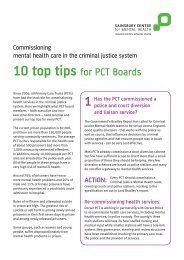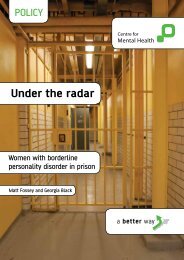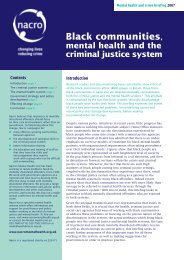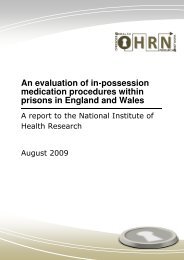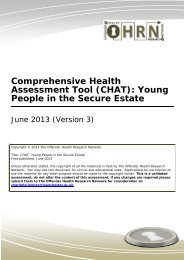Engendering Justice - from Policy to Practice - The Fawcett Society
Engendering Justice - from Policy to Practice - The Fawcett Society
Engendering Justice - from Policy to Practice - The Fawcett Society
- No tags were found...
You also want an ePaper? Increase the reach of your titles
YUMPU automatically turns print PDFs into web optimized ePapers that Google loves.
Chapter Three: Continued.Women and <strong>Justice</strong> – Meeting the Needs of Female Offenderstwelve staff members it is a difficult task. Unless trainingand information-sharing takes place consistently andpractice within the prisons is audited, implementation of theGSS within prisons and a real shift in the current mindsetis unlikely. Further resources need <strong>to</strong> be devoted <strong>to</strong> thedelivery of these standards and support provided within theprison service for the work of the NOMS team.<strong>The</strong>re have been some important changes on the ground.NOMS Women and Young People’s team and the CrossDepartmental Criminal <strong>Justice</strong> Women’s Unit should beparticularly commended for the introduction of the newarrangements for full searching, introduced in all femaleprisons in April 2009. 47 <strong>The</strong>se new arrangements meanthere will be a reduction in the number of full searchesrequired (with a search only <strong>to</strong> be conducted if there isintelligence or suspicion that an item is concealed) andwhen a full search is necessary this will not require stripsearching.This measure will go a long way <strong>to</strong> reducing thehumiliation and distress resulting <strong>from</strong> the previous over-useof strip searching, particularly for those women who havesuffered past abuse. <strong>The</strong> introduction of the two additionalpathways in women’s prisons in relation <strong>to</strong> violence againstwomen and women who sell sex is welcomed. Further, theintroduction of the Women Awareness Staff Programme(a two day training course) <strong>to</strong>gether with the Workingwith Women in Prison training DVD is also a significantachievement of the Women’s team.However, despite these important developments, evidenceindicates that the gap between policy and practical changeremains within the female prison estate.Mental Health, Deaths & Self Harm in Cus<strong>to</strong>dyIt is dreadful <strong>to</strong> live with women losing their lives in prison. 48When the Commission began its work in 2003, self-inflicteddeaths in cus<strong>to</strong>dy for women offenders for the year <strong>to</strong>talleda startling 14. At this time, the Commission urged the prisonservice “<strong>to</strong> address as a matter of urgency the spirallingincidence of death or self harm among women prisoners.” 49<strong>The</strong> numbers of deaths in cus<strong>to</strong>dy for female offendershave continued <strong>to</strong> fluctuate since this time. For examplein 2006, there were 3 self-inflicted deaths followed by 8female deaths in 2007. In 2008, the self-inflicted femaledeaths in cus<strong>to</strong>dy <strong>to</strong>talled only one, which was a welcomereduction. 50 However, at the time of writing this report, onewoman had already taken her life in January 2009 at HMPStyal, just one day in<strong>to</strong> her 28 day sentence .51Figures obtained by the Howard League for Penal Reformreveal, although women make up only 5 percent of the <strong>to</strong>talprison population, they commit around 50 percent of selfharmincidents. <strong>The</strong>re has been a dramatic rise in self-harmamong women since the inception of the Commission, withself-harm rates increasing by 48 percent between 2003 and2007. 52A national survey of 1,457 newly sentenced prisoners in2008 revealed that 18 percent of female prisoners hadlikely psychosis compared <strong>to</strong> 9 percent of men and 56percent of female prisoners had 6-10 symp<strong>to</strong>ms of anxietyand depression. 19 percent had attempted suicide and 14percent self harm in the year prior <strong>to</strong> cus<strong>to</strong>dy. 53 A Universityof Oxford study in<strong>to</strong> the health of female offendersconcluded that women in prison were five times more likely<strong>to</strong> have a mental health problem than women in the generalpopulation. 54<strong>The</strong>se statistics paint a picture of a criminal justice systemwhich is not only failing <strong>to</strong> respond <strong>to</strong> the mental healthneeds of women but is also not safeguarding their liveswhile in cus<strong>to</strong>dy. <strong>The</strong> recent inspec<strong>to</strong>rate report on HMPStyal, based on an unannounced inspection in September2008, noted that although there had been improvementswith the involvement of the local primary care trust, withinitiatives such as a mental health assessment for everywoman, the prison remained unable <strong>to</strong> meet “the scale andcomplexity of need.” 55 Staff lacked the training and support<strong>to</strong> deal with complex mental health issues such as self harmand as a result, the use of force and lock-up as a means of‘caring’ for these women had increased. <strong>The</strong> Commissionsupports the finding of the Inspec<strong>to</strong>rate that there is aneed for appropriate resources and a professionally ledtherapeutic environment <strong>to</strong> allow prisons such as Styal <strong>to</strong>meet the complex needs of the women living there.Significantly, the majority of prison workers who sharedtheir views with the Commission <strong>from</strong> seven of the femaleprisons expressed their concern that prison staff were notequipped <strong>to</strong> respond <strong>to</strong> the multi-layered needs of manyfemale prisoners. As one prison worker commented:Page 32







